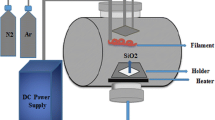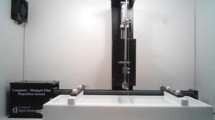Abstract
The amorphous W/WN films with various thickness (10, 30 and 40 nm) and excellent thermal stability were successfully prepared on SiO2/Si substrate with evaporation and reactive evaporation method. The W/WN bilayer has technological importance because of its low resistivity, high melting point, and good diffusion barrier properties between Cu and Si. The thermal stability was evaluated by X-ray diffractometer (XRD) and Scanning Electron Microscope (SEM). In annealing process, the amorphous W/WN barrier crystallized and this phenomenon is supposed to be the start of Cu atoms diffusion through W/WN barrier into Si. With occurrence of the high-resistive Cu3Si phase, the W/WN loses its function as a diffusion barrier. The primary mode of Cu diffusion is the diffusion through grain boundaries that form during heat treatments. The amorphous structure with optimum thickness is the key factor to achieve a superior diffusion barrier characteristic. The results show that the failure temperature increased by increasing the W/WN film thickness from 10 to 30 nm but it did not change by increasing the W/WN film thickness from 30 to 40 nm. It is found that the 10 and 40 nm W/WN films are good diffusion barriers at least up to 800°C while the 30 nm W/WN film shows superior properties as a diffusion barrier, but loses its function as a diffusion barrier at about 900°C (that is 100°C higher than for 10 and 40 nm W/WN films).
Similar content being viewed by others
References
H. Ono, T. Nakano, and T. Ohta, “Diffusion barrier effects against Cu of W–N layer formed by electron cyclotron resonance plasma nitridation on W layer,” Jpn. J. Appl. Phys. 34, 1827–1830 (1995).
S.P. Murarka, “Multilevel interconnections for ULSI and GSI era,” Mater. Sci. Eng., R 19, 87–151 (1997).
S. P. Murarka, R. J. Gutmann, A. E. Kaloyeros, and W. A. Lanford, “Advanced multilayer metallization schemes with copper as interconnection metal,” Thin Solid Films 236, 257–266 (1993).
M. Wittmer, “TiN and TaN as diffusion barriers in metallizations to silicon semiconductor devices,” Appl. Phys. Lett. 36, 456–458 (1980).
J. S. Becker, S. Suh, S. Wang, and R. G. Gordon, “Highly conformal thin films of tungsten nitride prepared by atomic layer deposition from a novel precursor,” Chem. Mater. 15, 2969–2976 (2003).
M. A. Nicolet, “Diffusion barriers in thin films,” Thin Solid Films 52, 415–443 (1978).
O. H. Gokce, S. Amin, N. M. Ravindra, D. J. Szostak, R. J. Paff, J. G. Fleming, C. J. Galewski, J. Shallenberger, and R. Eby, “Effects of annealing on X-rayamorphous CVD W–Si–N barrier layer materials,” Thin Solid Films 353, 149–156 (1999).
E. V. Anichenko, V. S. Arykov, E. V. Erofeev, and V. A. Kagadei, “Copper-metalized GaAs pHEMT with Cu/Ge ohmic contacts,” Int. J. Microwave Sci. Technol. 2012, 418264 (2012).
C. C. Tripathi, M. Kumar, and D. Kumar, “Effect of thin Mo2C layer on thermal stability of Si/SiO2/Ti/Cu system,” Bull. Mater. Sci. 34, 1611–1615 (2011).
W. Qingxiang, I. Shuhua, W. Xianhui, and F. Zhikang, “Diffusion barrier performance of amorphous W–Ti–N films in Cu metallization,” Vacuum 84, 1270–1274 (2010).
H. B. Bhandari, J. Yang, H. Kim, Y. Lin, R. G. Gordon, Q. M. Wang, J. S. M. Lehn, H. Li, and D. Shenai, “Chemical vapor deposition of cobalt nitride and its application as an adhesion-enhancing layer for advanced copper interconnects,” ECS J. Solid State Sci. Technol. 1, 79–84 (2010).
H. Kim, C. Cabral, C. Lavoie, and S. M. Rossnagel, “Diffusion barrier properties of transition metal thin films grown by plasma-enhanced atomic-layer deposition,” J. Vac. Sci. Technol., B: Microelectron. Nanometer Struct.–Process., Meas., Phenom. 20, 1321–1326 (2002).
M. Yan, M. Sob, D. E. Luzzi, V. Vitek, G. J. Ackland, M. Methfessel, and C. O. Rodriguez, “Interatomic forces and atomic structure of grain boundaries in copper–bismuth alloys,” Phys. Rev. B: Condens. Matter Mater. Phys. 47, 5571–5577 (1993).
H. Lee and S. D. Lopatin, “The influence of barrier types on the microstructure and electromigration characteristics of electroplated copper,” Thin Solid Films 492, 279–284 (2005).
A. R. Bushroa, R. G. Rahbari, H. H. Masjuki, and M. R. Muhamad, “Approximation of crystallite size and microstrain via XRD line broadening analysis in TiSiN thin films,” Vacuum 86, 1107–1112 (2012).
M. Uekubo, T. Oku, K. Nii, M. Murakami, K. Takahiro, S. Yamaguchi, T. Nakano, and T. Ohta, “WNx diffusion barriers between Si and Cu,” Thin Solid Films 286, 170–175 (1996).
R. Panwar, A. Dhingra, and D. Kumar, “Study of thermal stability behavior of MoN and WN thin films in ULSI,” Int. J. Adv. Eng. Technol. 1, 55–64 (2011).
T. G. Shen, Y. W. Mai, W. E. McBride, Q. C. Zhang, and D. R. McKenzie, “Structural properties and nitrogen-loss characteristics in sputtered tungsten nitride films,” Thin Solid Films 372, 257–264 (2000).
G. Kavei and G. A. Mohammadi, “The effects of surface roughness and nanostructure on the properties of indium tin oxide (ITO) designated for novel optoelectronic devices fabrication,” J. Mater. Process. Technol. 208, 514–519 (2008).
J. C. Fisher, “Calculation of diffusion penetration curves for surface and grain boundary diffusion,” J. Appl. Phys. 22, 74–76 (1951).
N. A. Gjostein, in Diffusion, Ed. by H. I. Aaronson (American Society for Metals, Metals Park, OH, 1973), Chap. 9, 241–274.
G. Martin and B. Perraillon, “Diffusion intergranulaire. La diffusion intergranulaire,” J. Phys. Colloques 36, C4: Int. Colloq. on Grain Boundaries in Metals, 165–190 (1975).
I. Kaur, Y. Mishin, and W. Gust, Fundamentals of Grain and Interphase Boundary Diffusion (Wiley, Chichester, 1995).
R. W. Balluffi, “Grain boundary diffusion mechanisms in metals,” Metall. Trans. B 13, 527–553 (1982).
M. Moriyama, T. Kawazoe, M. T. Anaka, and M. Murakami, “Correlation between microstructure and barrier properties of TiN thin films used Cu interconnects,” Thin Solid Films 416, 136–144 (2002).
S. Asgary, M. Hantehzadeh, M. Ghoranneviss, and A. Boochani, “Thermal stability of amorphous tungsten/tungsten nitride synthesis using HFCVD as a diffusion barrier for copper,” Appl. Phys. A 122, 518 (2016).
Author information
Authors and Affiliations
Corresponding author
Additional information
Published in Russian in Fizika Metallov i Metallovedenie, 2017, Vol. 118, No. 11, pp. 1191–1201.
The article is published in the original.
Rights and permissions
About this article
Cite this article
Asgary, S., Hantehzadeh, M.R. & Ghoranneviss, M. Temperature dependence of copper diffusion in different thickness amorphous tungsten/tungsten nitride layer. Phys. Metals Metallogr. 118, 1127–1135 (2017). https://doi.org/10.1134/S0031918X17100027
Received:
Accepted:
Published:
Issue Date:
DOI: https://doi.org/10.1134/S0031918X17100027




